Mostrar el registro sencillo del ítem
dc.contributor.author
Catanese, Francisco Hernan

dc.contributor.author
Fernandez, Paola Alejandra

dc.contributor.author
Villalba, Juan José

dc.contributor.author
Distel, Roberto Alejandro

dc.date.available
2017-07-05T13:48:41Z
dc.date.issued
2016-12
dc.identifier.citation
Catanese, Francisco Hernan; Fernandez, Paola Alejandra; Villalba, Juan José; Distel, Roberto Alejandro; The physiological consequences of ingesting a toxic plant (Diplotaxis tenuifolia) influence subsequent foraging decisions by sheep (Ovis aries); Elsevier; Physiology And Behavior; 167; 12-2016; 238-247
dc.identifier.issn
0031-9384
dc.identifier.uri
http://hdl.handle.net/11336/19567
dc.description.abstract
Toxins and nutrients interact and define herbivores' experiences with toxic plants. However, there are still open questions about the mechanisms by which nutrient-toxin interactions affect experience and as a consequence foraging decisions by consumers. This study provides a deeper insight into such mechanisms by using supplemental nutrients, a toxic plant typically avoided by herbivores (wild rocket; Diplotaxis tenuifolia), and a small ruminant (sheep; Ovis aries) as models. Thirty-six sheep were randomly assigned to four treatments (n = 9) where animals consumed: wild rocket (“DT”), wild rocket followed by a protein supplement (“DT + P”), wild rocket followed by a protein supplement + a mineral supplement containing iodine and copper (“DT + P + M”), or alfalfa pellets in amounts that paired the ingestion of wild rocket by DT (“CTRL”). Towards the end of the phase of exposure (day 35), DT showed the lowest intake of wild rocket, as well as reduced levels of plasma thyroid hormones (T3 and T4), alanine aminotransferase, and a trend towards reduced hemoglobin relative to DT + P and DT + P + M. Total concentration of serum proteins and albumins were greater in sheep fed the protein supplements, which have probably elicited a protective effect on toxin ingestion. Foraging behavior was then evaluated in an experimental arena where animals could select among randomly distributed buckets containing a fixed amount of wild rocket or variable amounts of barley grain (a preferred food). Regardless of barley grain availability, DT showed lower intake and lower times spent eating wild rocket than DT + P and DT + P + M. Unexpectedly, CTRL (without previous experience with wild rocket) ingested amounts of wild rocket comparable to those observed by DT + P and DT + P + M. A negative feeding experience with wild rocket is needed for animals to display the typical pattern of aversion commonly observed in grazing conditions.
dc.format
application/pdf
dc.language.iso
eng
dc.publisher
Elsevier
dc.rights
info:eu-repo/semantics/openAccess
dc.rights.uri
https://creativecommons.org/licenses/by-nc-sa/2.5/ar/
dc.subject
Experience
dc.subject
Foraging Behavior
dc.subject
Diet Selection
dc.subject
Nutrient-Toxin Interactions
dc.subject.classification
Ganadería

dc.subject.classification
Producción Animal y Lechería

dc.subject.classification
CIENCIAS AGRÍCOLAS

dc.title
The physiological consequences of ingesting a toxic plant (Diplotaxis tenuifolia) influence subsequent foraging decisions by sheep (Ovis aries)
dc.type
info:eu-repo/semantics/article
dc.type
info:ar-repo/semantics/artículo
dc.type
info:eu-repo/semantics/publishedVersion
dc.date.updated
2017-07-03T14:51:59Z
dc.journal.volume
167
dc.journal.pagination
238-247
dc.journal.pais
Países Bajos

dc.journal.ciudad
Amsterdam
dc.description.fil
Fil: Catanese, Francisco Hernan. Consejo Nacional de Investigaciones Científicas y Técnicas. Centro Científico Tecnológico Conicet - Bahía Blanca. Centro de Recursos Naturales Renovables de la Zona Semiarida. Universidad Nacional del Sur. Centro de Recursos Naturales Renovables de la Zona Semiarida; Argentina
dc.description.fil
Fil: Fernandez, Paola Alejandra. Consejo Nacional de Investigaciones Científicas y Técnicas. Centro Científico Tecnológico Conicet - Bahía Blanca. Centro de Recursos Naturales Renovables de la Zona Semiarida. Universidad Nacional del Sur. Centro de Recursos Naturales Renovables de la Zona Semiarida; Argentina
dc.description.fil
Fil: Villalba, Juan José. University of Utah; Estados Unidos
dc.description.fil
Fil: Distel, Roberto Alejandro. Consejo Nacional de Investigaciones Científicas y Técnicas. Centro Científico Tecnológico Conicet - Bahía Blanca. Centro de Recursos Naturales Renovables de la Zona Semiarida. Universidad Nacional del Sur. Centro de Recursos Naturales Renovables de la Zona Semiarida; Argentina
dc.journal.title
Physiology And Behavior

dc.relation.alternativeid
info:eu-repo/semantics/altIdentifier/doi/http://dx.doi.org/10.1016/j.physbeh.2016.09.009
dc.relation.alternativeid
info:eu-repo/semantics/altIdentifier/url/http://www.sciencedirect.com/science/article/pii/S0031938416308149
Archivos asociados
